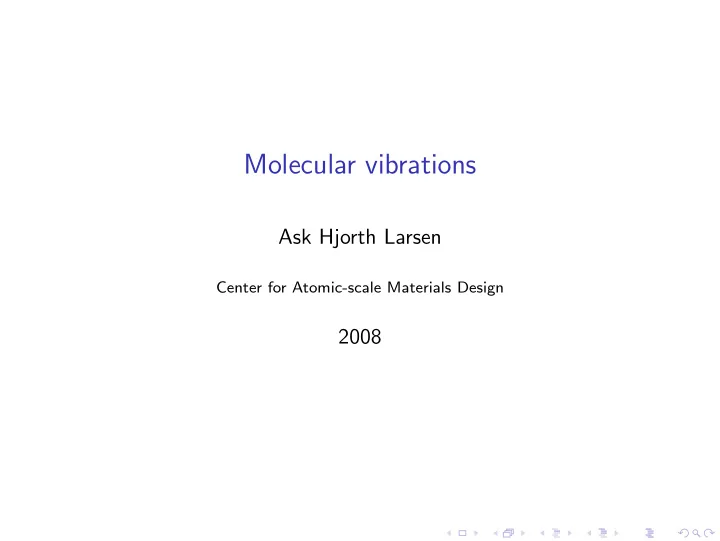

Molecular vibrations Ask Hjorth Larsen Center for Atomic-scale Materials Design 2008
Molecular vibrations Why this is interesting ◮ Molecular energy spectra are determined by electronic transitions, molecular vibrations, and molecular rotations ◮ Complex molecular vibrations are expressible in terms of simple normal modes ◮ These vibrational modes can be characterized by their symmetry properties, each mode “belonging” to an irreducible representation of the system
hello Example system: NH 3 ◮ Each atom has three positional degrees of freedom, for a total of 12 in the case of NH 3 ◮ Uniform dislocation of all atoms in x , y or z direction would be a translation. Thus three degrees of freedom are translational ◮ Similarly, three degrees of freedom are rotational ◮ Generally, the remaining 3 n − 6 degrees of freedom are vibrational ◮ Therefore there must be
Cartesian representation ◮ Consider n cartesian coordinate systems r i residing on each atom i = 1 . . . n ◮ The action of each symmetry operations on each coordinate determines a 3 n -dimensional representation Γ of the symmetry group ◮ For example, C 3 for NH 3 is represented by: 0 A 0 0 ↑ ↑ ↑ 0 0 A 0 = C 3 = C 3 (ˆ x 1 ) C 3 (ˆ y 1 ) C 3 (ˆ z n ) · · · A 0 0 0 ↓ ↓ ↓ 0 0 0 A where, for θ = 2 π 3 , cos θ − sin θ 0 A = sin θ cos θ 0 0 0 1
Irreducible representations of normal modes Reduction of Γ using character table of C 3 v C 3 v E 2 C 3 3 σ v A 1 1 1 1 z 1 1 − 1 A 2 R z E 2 − 1 0 ( x, y ) , ( R x , R y ) Γ 12 0 2 ← ( traces of E , C 3 , σ v ) ◮ Think of rows in the above table as vectors ◮ Then Γ = 3 A 1 + A 2 + 4 E ◮ But some operations are not proper vibrations! We discard representations corresponding to any of x, y, z, R x , R y , R z above, retaining 2 A 1 + 2 E
Interpretation ◮ The displacement vectors of normal mode form a basis for one of the irreducible representations A 1 and E ◮ For each irreducible representation in each point group, one can deduce (once and for all) whether normal modes belonging to that representation can are infrared or Raman active, or possibly both ◮ In our case we know that, A 1 and E contribute to both, for which reason all six normal modes will contribute to infrared as well as Raman spectra (which makes this a slightly boring result, but such is the price of relative simplicity) ◮ This procedure can be performed for any molecule, thus predicting numbers of spectral peaks
Actual vibrational modes Lowest two images depict A 1 modes, the remainder are E modes
Thank you for listening Incidentally, the Wikipedia article of the day is the one about groups.
Recommend
More recommend